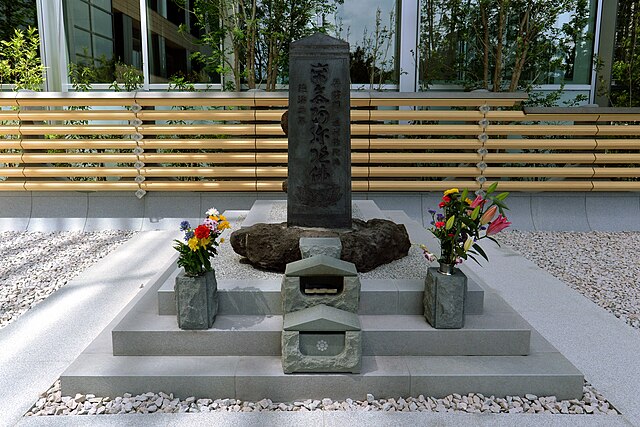In Japanese traditional beliefs and literature, onryō are a type of ghost believed to be capable of causing harm in the world of the living, injuring or killing enemies, or even causing natural disasters to exact vengeance to "redress" the wrongs it received while alive, then taking their spirits from their dying bodies. Onryō are often depicted as wronged women, who are traumatized, envied, disappointed, bitter, or just furious by what happened during life and exact revenge in death. These kinds of ghosts appear extremely vengeful, ruthless, heartless, brutal, cruel, deranged, egotistical, selfish, bloodthirsty, and cold-hearted.
Ukiyo-e by Utagawa Yoshitsuya depicts the moment when Emperor Sutoku, who died in exile, became an onryō.
The headstone of Taira no Masakado, located between the skyscrapers of Ōtemachi near Tokyo Station, was renovated in 2021 when the surrounding skyscrapers were rebuilt, but the headstone was never moved.
Ukiyo-e by Tsukioka Yoshitoshi depicting Sugawara no Michizane as the Tenjin (kami of thunder.). After Sugawara no Michizane's death, lightning struck the palace, killing and injuring many of the powerful people involved in his banishment, and Sugawara no Michizane was enshrined in the Tenmangū (Shinto shrines) as the Tenjin.
Onryō from the Kinsei-Kaidan-Shimoyonohoshi (近世怪談霜夜星)
In mythology and folklore, a vengeful ghost or vengeful spirit is said to be the spirit of a dead person who returns from the afterlife to seek revenge for a cruel, unnatural or unjust death. In certain cultures where funeral and burial or cremation ceremonies are important, such vengeful spirits may also be considered as unhappy ghosts of individuals who have not been given a proper funeral.
Vengeful ghost
As a husband passes by the place where his pregnant wife was brutally murdered, her ghost appears and hands their child to him. She then tells him the story of her murder and assists him as he takes revenge for her death. Utagawa Kuniyoshi 1845






